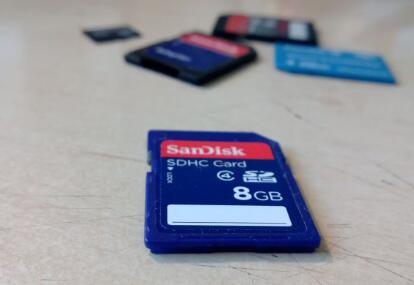The SD card is where all the captured images and videos are stored, and its size and speed directly impact your camera’s performance. Selecting the appropriate SD card size can significantly influence your camera’s efficiency, storage capacity, and overall functionality.
SD Card Basics
1. What Is an SD Card? An SD (Secure Digital) card is a compact, portable storage device used in various electronic devices, including game cameras. SD cards come in different sizes, storage capacities, and speeds, making them versatile and suitable for various applications.
2. Types of SD Cards There are three primary types of SD cards:
SD (Secure Digital): Standard capacity up to 2GB.
SDHC (Secure Digital High Capacity): High capacity ranging from 4GB to 32GB.
SDXC (Secure Digital eXtended Capacity): Extended capacity from 32GB up to 2TB.
For game cameras, SDHC and SDXC cards are the most commonly used due to their higher storage capacities.

Factors to Consider When Choosing an SD Card Size
1. Camera Resolution and Image Quality The resolution of your game camera plays a significant role in determining the appropriate SD card size. Higher resolution cameras produce larger image files and videos, which require more storage space. For instance:
Standard Resolution (5MP to 8MP): A 16GB to 32GB SD card might suffice.
High Resolution (10MP to 20MP): Consider 64GB to 128GB cards for optimal performance.
2. Frequency of Use The frequency with which you use your game camera affects the required SD card size. If you plan to deploy your camera in the field for extended periods without frequent maintenance, a larger SD card will prevent the need for regular card swaps. For example:
Short-Term Use (few days to a week): A 32GB card is generally sufficient.
Long-Term Use (several weeks to months): Opt for 64GB or larger cards.
3. Video Recording Needs If your game camera is used for video recording in addition to still images, the SD card size becomes even more critical. Videos, especially high-definition ones, consume significantly more storage space than photos. In this case:
Standard Video Quality: A 64GB card should be adequate for most applications.
High-Definition or 4K Videos: Consider using 128GB or 256GB cards for extended recording capabilities.
4. Frequency of Data Transfers The frequency with which you download and transfer data from your SD card also impacts the required size. If you prefer to transfer data frequently, you can opt for a smaller SD card. However, if you want to avoid frequent visits to your camera, a larger card is recommended.
Recommendations for Different Scenarios
1. For Casual Users If you use your game camera occasionally and don’t require extensive storage, a 32GB SD card should suffice. It provides a balance between storage capacity and cost and is ideal for users who do not need to store high-resolution images or long videos.
2. For Serious Enthusiasts For those who frequently use their game camera and prefer higher resolution images or videos, a 64GB or 128GB SD card is a better choice. It offers ample storage space for a significant number of high-quality photos and videos, reducing the need for frequent card changes.
3. For Professional Users Professional users who rely on game cameras for extensive fieldwork or research should consider using SD cards with capacities of 256GB or even higher. These cards provide ample storage for high-resolution images and extended video recordings, minimizing interruptions in data collection.
SD Card Speed and Performance
1. Speed Class Ratings SD cards come with speed class ratings that indicate their performance in terms of read and write speeds. The speed class ratings are:
Class 2: Minimum write speed of 2MB/s.
Class 4: Minimum write speed of 4MB/s.
Class 6: Minimum write speed of 6MB/s.
Class 10: Minimum write speed of 10MB/s.
For game cameras, a Class 10 SD card is generally recommended as it ensures fast data transfer rates, reducing the likelihood of lag or performance issues, especially when recording high-definition videos.
2. UHS (Ultra High Speed) Ratings UHS ratings offer even higher performance levels. UHS-I cards can achieve speeds up to 104MB/s, while UHS-II cards offer speeds up to 312MB/s. For most game cameras, a UHS-I card is sufficient, but if your camera supports UHS-II, it can be beneficial for faster data processing.
Tips for Optimal Performance
1. Format the SD Card Regularly Regularly formatting your SD card helps maintain its performance and ensures it operates smoothly. This process clears any corrupted data and optimizes the card for new recordings.
2. Use Quality SD Cards Invest in high-quality SD cards from reputable brands to ensure reliability and longevity. Cheap or counterfeit cards may not provide consistent performance and could lead to data loss.
3. Backup Important Data Always back up important data from your SD card to another storage medium. This precaution helps prevent data loss in case of card failure or accidental deletion.
4. Keep SD Cards in Good Condition Handle SD cards with care, avoiding exposure to extreme temperatures, moisture, or physical damage. Proper storage and maintenance extend the life of your SD card and ensure reliable performance.
About us and this blog
Panda Assistant is built on the latest data recovery algorithms, ensuring that no file is too damaged, too lost, or too corrupted to be recovered.
Request a free quote
We believe that data recovery shouldn’t be a daunting task. That’s why we’ve designed Panda Assistant to be as easy to use as it is powerful. With a few clicks, you can initiate a scan, preview recoverable files, and restore your data all within a matter of minutes.
Subscribe to our newsletter!
More from our blog
See all postsRecent Posts
- How to recover corrupted word file online? 2025-03-12
- Recover corrupted excel file online 2025-03-12
- Recover autocad file online 2025-03-12










